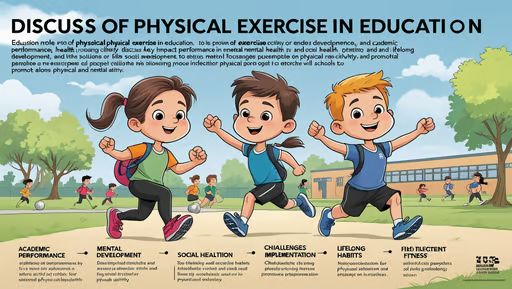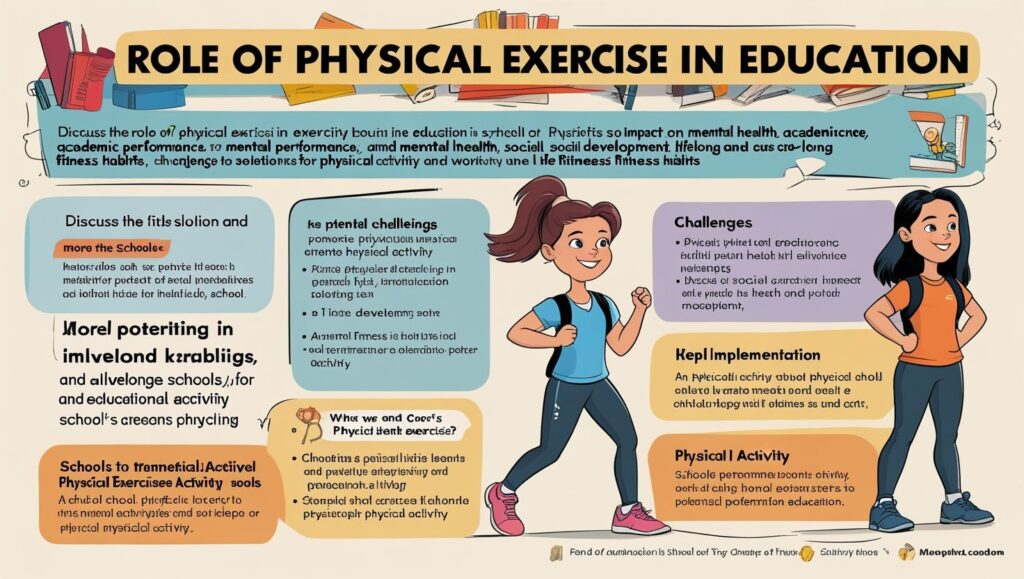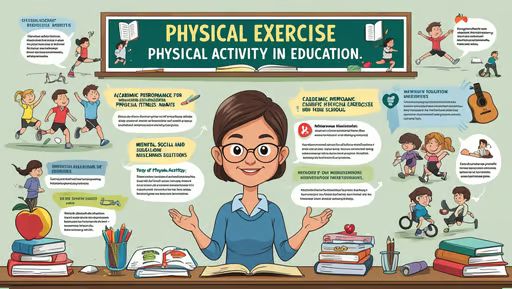Introduction
The Role of Physical Exercise in Education, Physical exercise has long been recognized as a crucial component of a well-rounded education. Beyond its obvious health benefits, physical activity plays a significant role in cognitive development, emotional well-being, and social skills enhancement. In the modern educational landscape, where academic pressures often dominate, the importance of physical exercise cannot be overstated. This article explores the multifaceted role of physical exercise in education, examining its impact on academic performance, mental health, social development, and lifelong fitness habits.
Physical Exercise and Academic Performance
1. Enhanced Cognitive Function
Numerous studies have demonstrated a strong correlation between physical activity and improved cognitive function. Exercise increases blood flow to the brain, promoting the growth of new neurons and enhancing memory, concentration, and problem-solving skills. According to research published in the Journal of School Health, students who engage in regular physical activity tend to perform better in standardized tests and exhibit higher levels of academic achievement.
2. Improved Focus and Classroom Behavior
Physical exercise helps reduce restlessness and improves attention spans in students. Activities such as short breaks for stretching, yoga, or even a quick walk can help students refocus during long study sessions. Schools that incorporate physical activity into their daily routines often report fewer behavioral issues and higher engagement in classroom activities.
3. Reduction of Stress and Anxiety
Academic pressures can lead to stress and anxiety among students. Physical exercise serves as a natural stress reliever by releasing endorphins, which improve mood and reduce feelings of anxiety. Programs that integrate physical education (PE) into the curriculum help students manage academic stress more effectively.
Physical Exercise and Mental Health
1. Combating Depression and Anxiety
The rise in mental health issues among students has made it imperative to incorporate exercise into school programs. Regular physical activity has been shown to reduce symptoms of depression and anxiety by promoting the release of serotonin and dopamine—neurotransmitters associated with happiness and relaxation.
2. Boosting Self-Esteem and Confidence
Participation in sports and physical activities helps students develop a sense of accomplishment. Whether through mastering a new skill, improving fitness levels, or working as part of a team, students gain confidence that translates into other areas of their lives.
3. Promoting Better Sleep Patterns
Adequate sleep is essential for learning and memory consolidation. Physical exercise helps regulate sleep cycles, ensuring that students are well-rested and more alert during school hours.

Social Development Through Physical Exercise
1. Teamwork and Cooperation
Sports and group fitness activities teach students the value of teamwork, leadership, and cooperation. These skills are transferable to academic group projects and future workplace environments.
2. Discipline and Time Management
Engaging in regular physical activity requires discipline and time management. Student-athletes often develop strong organizational skills, balancing academics and sports effectively.
3. Reducing Social Isolation
Physical education classes and extracurricular sports provide opportunities for students to socialize, make friends, and develop interpersonal skills. This is particularly important in preventing feelings of loneliness and social exclusion.
Lifelong Health Benefits
1. Preventing Obesity and Chronic Diseases
Childhood obesity is a growing concern worldwide. Schools that prioritize physical education help instill healthy habits early, reducing the risk of obesity, diabetes, and cardiovascular diseases in adulthood.
2. Encouraging an Active Lifestyle
Students who develop a positive attitude toward exercise in school are more likely to remain physically active as adults. This contributes to long-term health and well-being.
3. Developing Motor Skills and Coordination
Physical activities such as running, jumping, and playing sports enhance motor skills, balance, and coordination, which are essential for overall physical development.

Challenges and Solutions in Implementing Physical Exercise in Education
1. Limited School Budgets and Resources
Many schools struggle with insufficient funding for sports facilities and PE programs. Solutions include:
- Partnering with local sports clubs and community organizations.
- Integrating low-cost physical activities like walking clubs or dance sessions.
2. Overemphasis on Academics
With increasing academic demands, physical education is often sidelined. Schools should adopt a balanced approach by:
- Incorporating short physical activity breaks between classes.
- Highlighting the link between physical fitness and academic success.
3. Lack of Trained Physical Education Instructors
Investing in qualified PE teachers and professional development programs can enhance the quality of physical education in schools.
Conclusion
Physical exercise is not just an optional part of education—it is a fundamental pillar that supports academic success, mental health, social development, and lifelong well-being. Schools must prioritize physical education by integrating it into daily routines, providing adequate resources, and fostering a culture that values both mind and body. By doing so, we can nurture healthier, happier, and more successful future generations.

3 thoughts on “The Role of Physical Exercise in Education”
Comments are closed.